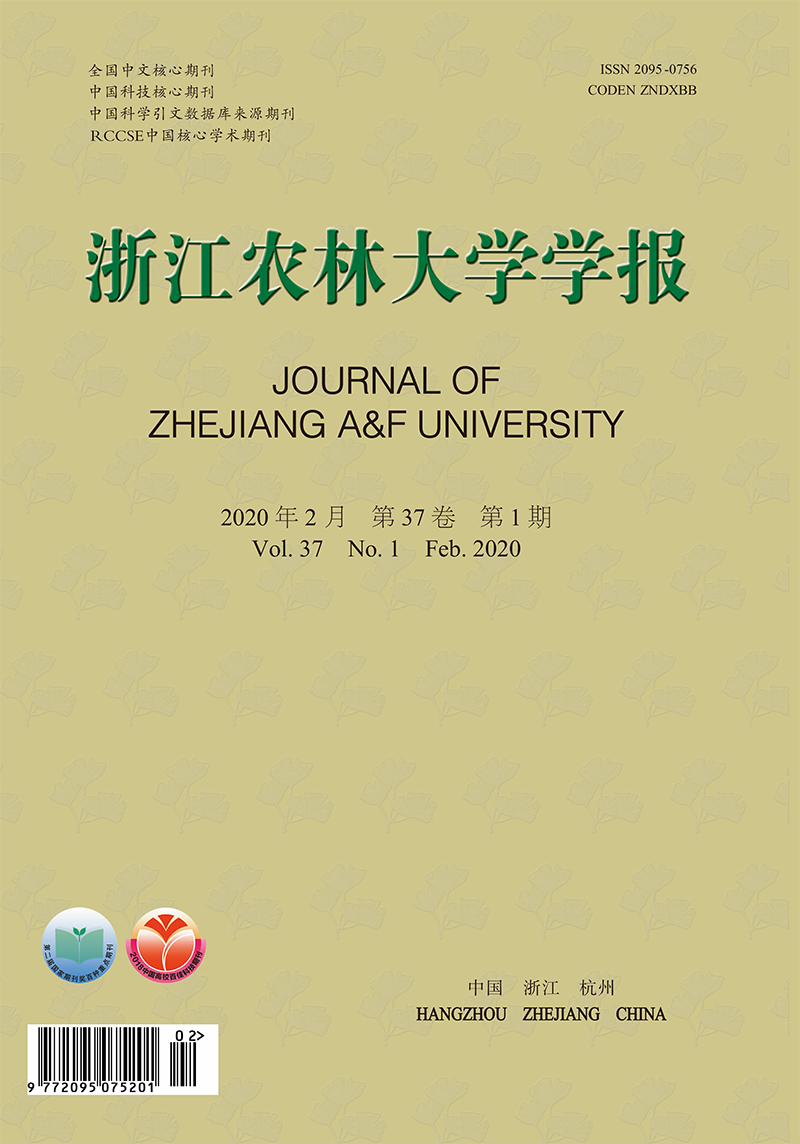-
南瓜Cucurbita moschata又名倭瓜,是葫芦科Cucurbitaceae南瓜属Cucurbita植物。南瓜富含多糖、类胡萝卜素、果胶、矿质元素和氨基酸等,营养丰富,具有较高的医疗保健价值[1-2]。南瓜种质资源十分丰富,是经济价值最重要的物种之一[3],世界各地广泛栽培。屈淑平等[4]对76份南瓜材料进行遗传多样性分析,提出了南瓜资源植物学描述评价的代表性状。刘振威等[5]对51种南瓜杂交组合的11个主要农艺性状进行相关分析和聚类分析发现,7个主要数量性状变异潜力丰富。果实品质由果品外观和内质两者复合构成,评价指标复杂,在综合评价种质资源时,考察的多个性状间通常存在一定相关性,造成信息重复而影响其准确性。如GOMES等[6]通过分析影响氧化酶失活动力学与南瓜颜色的变化关系,发现南瓜外观颜色性状的变化受氧化酶、温度等多种因素共同影响。主成分分析(principal component analysis)通过降维将个数较多且彼此相关的变量重新组合,形成个数较少、彼此独立并尽可能多地反映原变量信息的综合变量,简化了多指标,又为资源的评价和选择提供了科学依据[7]。目前主成分分析被广泛应用于作物[8-12],而在南瓜品质评价方法和评价指标体系方面的研究较少。本研究以10份南瓜品种为材料,分析不同南瓜品种生物学性状与果实品质,构建科学的评价体系,以期为优质南瓜资源的快速筛选及品种选育提供理论依据。
HTML
-
供试南瓜品种共10个,包括美洲南瓜类型:‘奶油NL1’‘Cream NL1’、‘奶油NL2’‘Cream NL1’、‘奶油Y’‘Cream Y’;中国南瓜类型:‘玩偶’‘Doll’、‘蜜本’‘NGMB’、‘黄狼’‘Yellow Wolf’;印度南瓜类型:‘锦栗’‘Jin Li’、‘旭日’‘Rising Sun’、‘红栗’‘Red Chestnut’、‘日本黑’‘Black Japan’。所有品种均于2017年3月定植在浙江农林大学实验基地,株行距为90 cm,日常栽培管理及病虫害防治方法采用相同标准进行,采收后立即运至浙江农林大学农产品品质改良技术研究重点实验室。
-
记录各南瓜品种雌首花节位、收获日期,植株的分枝性;采用便携式叶绿素仪测定南瓜叶片叶绿素质量分数;游标卡尺测定茎及叶柄直径。参照Galet叶形结构参数分析法[12],测量南瓜叶片中脉和下侧脉。于南瓜最大直径处测定南瓜周长和肉厚。采用色差仪(CR-10)测定南瓜的果皮、果肉颜色,并计算色度值(C)和色调角(H)[13]。采用蒽酮比色法[14]测定可溶性糖质量分数,碘显色法[15]测定淀粉质量分数,并测定南瓜种子的长度、厚度等相关指标。采用TA-XT plus型物性测试仪(英国Stable Micro Systems公司)对南瓜进行穿刺分析。试验中采用的探头为圆柱形P/2E探头,直径为2 mm。测试参数为测前速度1 mm·s-1,测试速度1 mm·s-1,测后上行速度1 mm·s-1。所有指标测定均重复5次。
-
采用Excel和SPSS 19.0对数据进行分析处理。利用SPSS软件中的因子分析对南瓜性状进行主成分提取和相关性分析。综合评价时对各性状指标进行无量纲化,X(μ)=(X-Xmin)/(Xmax-Xmin),其中:X为某品种某一指标的测定值;Xmax为所有品种某一指标测定的最大值;Xmin为该指标中的最小值。
1.1. 试验材料
1.2. 试验方法
1.3. 数据统计分析
-
南瓜不同品种间植株性状存在较大差异。‘玩偶’雌首花节位最高,与‘日本黑’‘锦栗’‘奶油Y’‘奶油NL1’‘蜜本’及‘旭日’差异显著;‘红栗’和‘蜜本’分枝性较强;‘奶油Y’‘锦栗’‘蜜本’主蔓直径均超过1 cm,‘蜜本’主蔓直径是‘奶油NL2’的2.18倍;‘日本黑’叶柄直径、叶片显著大于其他9个品种(叶片中脉、下侧脉最大),而‘玩偶’叶片则是所有品种中最小的;所有品种植株均被毛,其中‘红栗’和‘日本黑’植株被刺毛,‘旭日’被绒毛,其余品种被糙毛或粗毛;‘旭日’和‘锦栗’的叶绿素SPAD值显著高于其他品种,‘日本黑’叶绿素SPAD值却最低(表 1)。
品种 雌首花节位 分枝性 主蔓直径/cm 叶柄直径/cm 叶片中脉/cm 叶片下侧脉/cm 植株被毛 叶绿素SPAD值 ‘奶油NL1’ 6.3 b 中 0.99 ab 1.02 bc 15.17 bc 9.07 cd 糙毛 34.2 c ‘奶油NL2’ 12.7 ab 中 0.68 b 1.03 bc 21.17 abc 12.10 bcd 被毛 38.0 abc ‘奶油Y’ 6.7 b 中 1.24 ab 1.29 ab 19.10 abc 15.34 b 糙毛 35.6 abcde ‘玩偶’ 15.1 a 中 0.84 b 0.39 d 13.80 c 7.21 d 被毛 33.6 c ‘锦栗’ 7.0 b 中 1.06 ab 1.07 bc 18.10 bc 12.16 bcd 糙毛 42.5 a ‘旭日’ 5.0 b 中 0.97 ab 1.31 ab 18.22 bc 14.22 b 绒毛 43.5 a ‘红栗’ 9.3 ab 强 0.99 ab 1.32 ab 21.57 ab 15.36 b 刺毛 34.8 c ‘蜜本’ 6.3 b 强 1.48 a 1.04 bc 20.67 abc 14.14 bc 糙毛 41.1 ab ‘日本黑’ 7.7 b 中 0.97 ab 1.81 a 25.88 a 24.89 a 刺毛 33.1 c ‘黄狼’ 8.3 ab 中 0.99 ab 0.78 cd 20.55 abc 12.14 bcd 糙毛 34.2 c 说明:同列数据后不同字母表示品种间差异显著(P < 0.05) Table 1. Biological characteristics comparison of different pumpkin cultivars
-
不同南瓜品种间果实性状差异较大。10个品种间‘红栗’肉色色度值最高,色度角则最低。‘黄狼’最长,是‘奶油NL1’的3.06倍;‘红栗’周长最大,‘玩偶’最小;‘旭日’瓜肉最厚,达4.10 cm,是‘奶油NL1’的2.73倍;‘红栗’单果质量最大,是‘玩偶’的7.05倍。南瓜品种间可溶性糖和淀粉质量分数差异显著,其中‘锦栗’的可溶性糖和淀粉质量分数均最高,分别是‘奶油NL2’的1.97倍、1.92倍。‘锦栗’和‘旭日’均果柄中空、扁圆形,瓜面有条纹或浅棱,中等程度瓜瘤,‘锦栗’蜡粉多于‘旭日’;‘玩偶’果实表面黄绿分界明显。品种间瓜棱表现也有差异,‘日本黑’有深棱,‘奶油NL1’和‘奶油Y’无棱,其余品种有浅棱。‘红栗’‘蜜本’和‘日本黑’瓜瘤与‘锦栗’和‘旭日’类似。‘奶油Y’和‘蜜本’表面蜡粉较多,‘奶油NL2’和‘黄狼’蜡粉中等,‘日本黑’表面无蜡粉(表 2)。
品种 皮色 肉色 瓜长/cm 周长/cm 瓜肉厚/cm 单果质量/kg 可溶性糖/(mg·g-1) 淀粉/(mg·g-1) 果柄 瓜形 瓜面斑纹 瓜棱 瓜瘤 C H C H ‘奶油NL1’ 34.7 d 1.1 cd 67.4 c 1.2 cd 14.2 cd 28.6 g 1.5 e 0.43 c 1.86 d 1.67 d 紧实 梨形 无花斑 无棱 无 ‘奶油NL2’ 31.0 d 0.9 e 66.9 c 1.3 bc 18.4 c 39.9 e 2.3 cde 1.16 b 1.45 e 1.33 e 紧实 梨形 无花斑 浅棱 无 ‘奶油Y’ 31.6 d 1.0 de 66.9 c 1.2 bcd 32.1 b 45.1 d 2.38 cd 1.68 b 1.62 e 1.45 de 紧实 长把梨形 橙色条斑 无棱 无 ‘玩偶’ 4.8 f
(65.9 a)31.5 d
(1.1 bc)31.5 d 1.5 a 13.6 cd 24.3 h 1.6 de 0.38 c 2.64 b 2.34 ab 紧实 梨形 黄绿分界 浅棱 无 ‘锦栗’ 65.7 a 1.5 a 70.2 c 1.2 bcd 12.2 d 78.2 b 3.5 ab 2.38 a 2.85 a 2.56 a 中空 扁圆 条纹 浅棱 中 ‘旭日’ 60.9 ab 0.6 g 76.4 b 1.2 d 14.3 cd 75.1 b 4.1 a 2.37 a 2.63 b 2.38 ab 中空 扁圆 条纹 浅棱 中 ‘红栗’ 58.7 b 0.6 g 92.6 a 0.8 e 14.8 cd 96.2 a 3.6 a 2.68 a 2.63 b 2.38 ab 紧实 扁圆 条纹 浅棱 中 ‘蜜本’ 51.6 c 1.2 b 68.2 c 1.3 bc 39.6 a 43.2 d 2.7 bc 2.56 a 2.63 b 2.37 ab 紧实 棒槌形 浅黄条斑 浅棱 中 ‘日本黑’ 21.5 e 1.4 a 67.2 c 1.2 bcd 13.8 cd 54.3 c 3.5 ab 2.35 a 2.45 b 2.19 bc 紧实 扁圆 浅绿花斑 深棱 中 ‘黄狼’ 29.4 d 1.0 cd 67.9 c 1.3 b 53.5 a 36.3 f 3.6 a 2.39 a 2.16 c 1.96 c 紧实 棒槌形 绿色条斑 浅棱 无 说明:C表示色度值,H表示色调角;‘玩偶’的皮色括号外数据为绿色部分的,括号内数据为黄色部分的;同列数据后不同字母表示品种间差异显著(P<0.5) Table 2. Fruit traits of different pumpkin cultivars
-
南瓜果皮和果肉的穿刺试验发现:‘奶油NL2’果皮硬度最高,‘玩偶’果皮硬度最低,仅为‘奶油NL2’的30.32%;‘奶油NL1’‘奶油Y’‘红栗’及‘蜜本’的果皮硬度相近。奶油系列3个品种和‘黄狼’果肉相对较硬,‘奶油NL1’果肉硬度显著大于‘玩偶’‘旭日’‘红栗’‘蜜本’和‘日本黑’。而‘旭日’的果肉硬度最低,仅7.83 N。‘奶油NL2’和‘黄狼’果肉硬度差异不大。南瓜品种间果皮韧性差异较大。‘奶油NL1’果皮韧性最大,‘红栗’果皮韧性最小。‘奶油NL1’‘奶油Y’和‘黄狼’的果皮韧性差异显著(图 1)。
-
不同南瓜品种间种子形态特征也存在差异。‘旭日’种子数最多,奶油系列种子数较少,‘奶油NL2’种子数仅为‘旭日’的14.41%。‘红栗’种子质量最大,达0.62 g,‘玩偶’最轻,仅0.14 g。‘奶油NL1’和‘玩偶’的种子横径均低于1 cm。‘红栗’种子的纵径和厚度显著大于其他品种(表 3)。
品种 种子数量 种子单粒质量/g 种子横径/cm 种子纵径/cm 种子厚度/cm ‘奶油NL1’ 32.1 f 0.21 ed 0.61 c 1.21 de 0.29 cd ‘奶油NL2’ 30.3 f 0.23 d 1.09 a 1.62 c 0.24 d ‘奶油Y’ 35.3 f 0.24 d 1.13 a 1.62 c 0.26 cd ‘玩偶’ 74.0 e 0.14 e 0.81 b 1.13 e 0.32 cd ‘锦栗’ 173.3 c 0.43 b 1.13 a 1.83 b 0.52 ab ‘旭日’ 221.7 a 0.49 b 1.22 a 1.87 b 0.49 b ‘红栗’ 178.0 c 0.62 a 1.27 a 2.16 a 0.66 a ‘蜜本’ 198.3 b 0.49 b 1.12 a 1.22 de 0.32 cd ‘日本黑’ 204.3 ab 0.32 c 1.13 a 1.31 d 0.41 bc ‘黄狼’ 152.3 d 0.49 b 1.20 a 1.62 c 0.28 cd 说明:同列数据后不同字母表示品种间差异显著(P<0.5) Table 3. Seed traits of different pumpkin cultivars
-
对10个南瓜品种的30个性状指标进行主成分分析,得到了特征值大于l的5个主成分,反映了总信息量的87.240%,能够在较大程度上反映出原始信息(表 4)。5个主成分中第1主成分的方差贡献率为37.537%,其中瓜肉厚、种子数量、单果质量、周长、种子单粒质量、种子厚度、种子横径、皮色、淀粉质量分数、可溶性糖质量分数、肉色、种子纵径等具有较大的载荷值,综合反映了南瓜产量、果实、种子各方面的性状,因此第1主成分能作为选择综合性状较好的优质南瓜种质资源的有效指标。第2主成分的方差贡献率为16.630%,蜡粉、果皮硬度、瓜形、瓜长等具有较大的载荷值,主要反映了南瓜的商品性状。第3主成分的方差贡献率为14.353%,特征向量值较大的是叶片中脉、叶片下侧脉、分枝性、叶柄直径等,主要反映了南瓜植株的生长性状。第4主成分的方差贡献率为10.494%,特征向量值较大的是主蔓直径。第5主成分在每个指标的载荷值不突出,但增加了整个综合模型的信息表达量,使模型能更全面反映南瓜的综合性状。
主成分 特征值 方差贡献率/% 累计方差贡献率/% 1 11.261 37.537 37.537 2 4.989 16.630 54.167 3 4.306 14.353 68.520 4 3.148 10.494 79.014 5 2.468 8.227 87.240 Table 4. Characteristic value and cumulative variance contribution rate of pumpkin evaluation factor
为消除不同单位和数据量纲的影响,对各性状指标原始数据进行无量纲化处理。根据表 5构建主成分与南瓜各生物学性状之间的线性关系式:
F1=0.911X1+0.907X2+0.888X3+0.874X4+0.827X5+0.811X6+0.759X7+0.717X8-0.696X9+0.695X10+0.676X11+0.639X12+0.623X13-0.541X14+0.499X15-0.186X16-0.121X17+0.546X18-0.123X19-0.245X20-0.551X21+0.516X22+0.571X23+0.289X24+0.579X25+0.553X26-0.563X27+0.255X28-0.477X29+0.459X30。
F2=-0.124X1+0.132X2+0.299X3+0.063X4+0.318X5-0.20X6+0.264X7+0.487X8+0.408X9-0.386X10-0.406X11+0.505X12+0.317X13+0.505X14+0.349X15+0.758X16+0.748X17-0.593X18+0.592X19-0.579X20+0.567X21+0.040X22-0.111X23-0.195X24+0.068X25-0.125X26-0.082X27+0.493X28-0.586X29-0.206X30。
F3=0.038X1+0.077X2+0.223X3-0.181X4-0.078X5-0.315X6+0.211X7-0.341X8-0.141X9-0.387X10-0.386X11+0.163X12-0.249X13+0.066X14-0.426X15-0.077X16+0.241X17+0.371X18+0.261X19+0.372X20+0.206X21+0.814X22+0.774X23+0.660X24+0.613X25-0.570X26+0.565X27+0.112X28-0.105X29+0.408X30。
F4=0.304X1-0.084X2+0.135X3-0.371X4+0.045X5-0.287X6-0.032X7-0.149X8-0.377X9+0.380X10+0.392X11-0.443X12-0.557X13-0.157X14+0.151X15+0.369X16-0.345X17+0.039X18-0.511X19-0.266X20+0.450X21-0.128X22-0.050X23+0.539X24-0.299X25+0.319X26+0.088X27+0.682X28-0.132X29-0.045X30。
F5=-0.006X1+0.089X2+0.205X3+0.075X4+0.308X5+0.075X6+0.42X7-0.106X8+0.165X9+0.027X10+0.016X11+0.027X12+0.295X13-0.473X14-0.224X15+0.270X16+0.193X17+0.202X18+0.403X19+0.513X20+0.189X21+0.200X22-0.158X23-0.145X24-0.381X25+0.260X26+0.403X27-0.137X28+0.591X29-0.541X30。
性状 主成分 1 2 3 4 5 种子数量(X1) 0.911 -0.124 0.038 0.304 -0.006 瓜肉厚(X2) 0.907 0.132 0.077 -0.084 0.089 单果质量(X3) 0.888 0.299 0.223 0.135 0.205 周长(X4) 0.874 0.063 -0.181 -0.371 0.075 种子单粒质量(X5) 0.827 0.318 -0.078 0.045 0.308 种子厚度(X6) 0.811 -0.200 -0.315 -0.287 0.075 种子横径(X7) 0.759 0.264 0.211 -0.032 0.420 皮色(X8) 0.717 0.487 -0.341 -0.149 -0.106 果肉硬度(X9) -0.696 0.408 -0.141 -0.377 0.165 淀粉质量分数(X10) 0.695 -0.386 -0.387 0.380 0.027 可溶性糖质量分数(X11) 0.676 -0.406 -0.386 0.392 0.016 肉色(X12) 0.639 0.505 0.163 -0.443 0.027 种子纵径(X13) 0.623 0.317 -0.249 -0.557 0.295 果皮初性(X14) -0.541 0.505 0.066 -0.157 -0.473 质量分数(X15) 0.499 0.349 -0.426 0.151 -0.224 蜡粉(X16) -0.186 0.758 -0.077 0.369 0.270 果皮硬度(X17) -0.121 0.748 0.241 -0.345 0.193 瓜棱(X18) 0.546 -0.593 0.371 0.093 0.202 瓜长(X19) -0.123 0.592 0.261 0.511 0.403 植株被毛(X20) -0.245 -0.579 0.372 -0.266 0.513 瓜形(X21) -0.551 0.567 0.206 0.450 0.189 叶片中脉(X22) 0.516 0.040 0.814 -0.128 0.200 叶片下侧脉(X23) 0.571 -0.111 0.774 -0.050 -0.158 分枝性(X24) 0.289 -0.195 0.660 0.539 -0.145 直径(X25) 0.579 0.068 0.613 -0.299 -0.381 瓜面斑纹(X26) 0.553 -0.125 -0.570 0.319 0.260 果柄(X27) -0.563 -0.082 0.565 0.088 0.403 主蔓直径(X28) 0.255 0.493 0.112 0.682 -0.137 雌首花节位(X29) -0.477 -0.586 -0.105 -0.132 0.591 瓜瘤(X30) 0.459 -0.206 0.408 -0.045 -0.541 Table 5. Rotated component matrix of the principle component analysis
在主成分分析的基础上,以5个主成分及每个主成分对应的特征值占提取主成分总特征值之和的比例作为权重,计算主成分综合模型:F综=0.32F1+0.15F2+0.17F3+0.14F4+0.22F5,根据综合模型计算不同品种南瓜的综合性状得分(表 6)。结果表明:‘红栗’的综合性状最好,‘蜜本’‘日本黑’略低于‘红栗’,其次是‘锦栗’‘奶油Y’和‘旭日’,‘奶油NL1’的综合品质最差,其他品种居中。
品种 F1 F2 F3 F4 F5 F综 排名 ‘奶油NL1’ 4.04 0.75 0.54 -0.26 0.86 1.65 10 ‘奶油NL2’ 4.57 0.96 0.96 -0.27 0.96 1.94 7 ‘奶油Y’ 5.04 1.03 0.61 -0.04 0.98 2.08 5 ‘玩偶’ 4.06 1.22 0.86 -0.06 0.89 1.81 9 ‘锦栗’ 5.55 1.21 0.54 -0.30 1.24 2.28 4 ‘旭日’ 4.96 1.09 0.87 -0.35 0.95 2.06 6 ‘红栗’ 6.37 1.54 0.92 -0.27 1.21 2.65 1 ‘蜜本’ 5.88 1.59 0.65 -0.20 1.13 2.45 2 ‘日本黑’ 5.88 1.50 0.74 -0.27 1.14 2.45 3 ‘黄狼’ 4.32 1.39 0.72 -0.10 0.84 1.88 8 Table 6. Prediction results of different characteristics of pumpkin cultivars
2.1. 不同南瓜品种植株性状比较
2.2. 不同南瓜品种果实性状比较
2.3. 不同南瓜品种质地特性比较
2.4. 不同南瓜品种种子性状比较
2.5. 不同南瓜品种品质性状的主成分分析
-
南瓜具有外形优美、品质独特且营养价值高等优点。前人研究发现南瓜种质资源间的形态学性状具有遗传多样性[16],且不同基因型南瓜的叶长、叶厚、分枝数、单果质量、果皮色、果肉色等具有显著差异。本研究对10个南瓜品种的各项生物学性状和品质特性进行测定,发现‘奶油NL1’‘奶油Y’‘红栗’‘蜜本’‘日本黑’的雌首花节位靠前,‘红栗’‘蜜本’的分枝性强,‘奶油Y’‘锦栗’‘蜜本’的主蔓直径较大,‘日本黑’等叶柄直径较大,成熟叶较大、叶绿素含量较高。本试验还发现雌首花节位低、分枝性强、叶柄直径、叶面积大的南瓜品种同时具备早熟、丰产、生长健壮等优点,且单果质量对早期产量的影响大于周长和瓜肉厚,这与张宏荣[17]通过灰色关联度分析的结果一致。杜晓华等[18]也得出生长因子对于南瓜早熟丰产的贡献率最高的结论,这也与LABBAFI等[19]利用模型估算南瓜叶面积指数与干物质量及植株长势间关系的分析结果相近。尹玲[20]认为南瓜干物质含量与品质综合评分呈显著正相关,可作为初步判定南瓜感官性状优劣的生化指标,其中可溶性糖及淀粉含量是瓜肉综合评价性状的重要因素[21]。本试验中,‘锦栗’的可溶性糖和淀粉质量分数显著高于其他南瓜品种,说明‘锦栗’果肉熟食口味更佳[22]。
南瓜果柄和瓜形是区别南瓜不同品种的重要依据[23]。中空果柄南瓜多呈扁圆形,瓜面有条纹或浅棱,具瓜瘤和蜡粉;而紧实果柄南瓜形态则更丰富,与徐鹏程[24]研究的果柄对果实发育存在较大影响的结果一致。扁圆瓜形,横径大,单果质量较大的南瓜,种子数也较多。本研究也发现有最大周长和单果质量最大的‘红栗’南瓜,种子单粒质量也最大。果皮颜色是判断果实成熟的重要评价指标之一,刘旭等[25]证实果实成熟期间花色苷含量逐渐增加。从皮色上看,‘红栗’为橙红色系列,‘锦栗’为深绿色系列;从肉色上看,‘红栗’饱和度最高,‘玩偶’果实外观特征新颖,肉色饱和度低,颜色浅。‘红栗’和‘旭日’的皮色及肉色饱和度较高,在观赏长廊中常作为观赏蔬菜种植,具较高的观赏价值。
本研究测定了10个南瓜品种的植株生长、果实及种子性状相关指标,比较南瓜品种间的差异,并在此基础上采用主成分分析法对不同南瓜品种进行综合评价。结果表明不同南瓜品种间存在显著差异,如‘日本黑’的叶柄直径大、叶片最大,‘锦栗’的可溶性糖和淀粉质量分数最高,‘红栗’肉色色度值最高,奶油系列和‘黄狼’果肉较硬等。对10个南瓜品种的30个性状进行主成分分析,提取出5个主成分,累积方差贡献率达87.240%,确立了南瓜评价综合得分模型,计算出红栗的综合性状最好,‘蜜本’‘日本黑’略低于‘红栗’,其次是‘锦栗’‘奶油Y’‘旭日’,‘奶油NL1’的综合性状最差。








 DownLoad:
DownLoad: